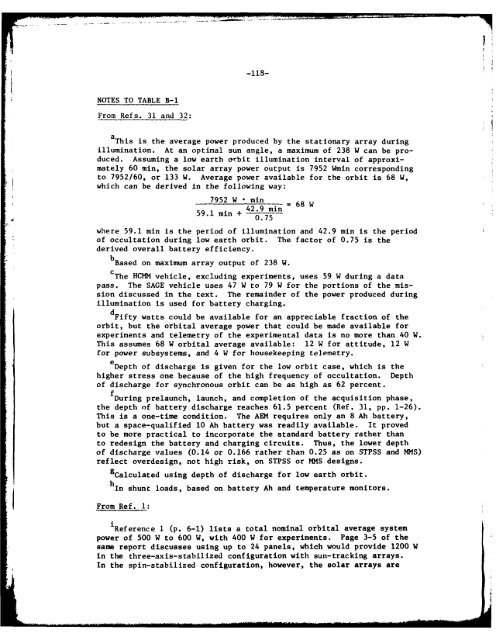A Case Study in NASA-DoD - The Black Vault
A Case Study in NASA-DoD - The Black Vault
A Case Study in NASA-DoD - The Black Vault
You also want an ePaper? Increase the reach of your titles
YUMPU automatically turns print PDFs into web optimized ePapers that Google loves.
-118-<br />
NOTES TO TABLE B-i<br />
From Refs. 31 and 32:<br />
aThis is the average power produced by the stationary array dur<strong>in</strong>g<br />
illum<strong>in</strong>ation. At an optimal sun angle, a maximum of 238 W can be produced.<br />
Assum<strong>in</strong>g a low earth orbit illum<strong>in</strong>ation <strong>in</strong>terval of approximately<br />
60 m<strong>in</strong>, the solar array power output is 7952 Wm<strong>in</strong> correspond<strong>in</strong>g<br />
to 7952/60, or 133 W. Average power available for the orbit is 68 W,<br />
which can be derived <strong>in</strong> the follow<strong>in</strong>g way:<br />
7952 W , m<strong>in</strong><br />
7952 W 42.9 <strong>in</strong> 68 W<br />
59.1 m<strong>in</strong> + 0.75<br />
where 59.1 m<strong>in</strong> is the period of illum<strong>in</strong>ation and 42.9 m<strong>in</strong> is the period<br />
of occultation dur<strong>in</strong>g low earth orbit. <strong>The</strong> factor of 0.75 is the<br />
derived overall battery efficiency.<br />
bBased on maximum array output of 238 W.<br />
C<strong>The</strong> HCMM vehicle, exclud<strong>in</strong>g experiments, uses 59 W dur<strong>in</strong>g a data<br />
pass. <strong>The</strong> SAGE vehicle uses 47 W to 79 W for the portions of the mission<br />
discussed <strong>in</strong> the text. <strong>The</strong> rema<strong>in</strong>der of the power produced dur<strong>in</strong>g<br />
illum<strong>in</strong>ation is used for battery charg<strong>in</strong>g.<br />
dFifty watts could be available for an appreciable fraction of the<br />
orbit, but the orbital average power that could be made available for<br />
experiments and telemetry of the experimental data is no more than 40 W.<br />
This assumes 68 W orbital average available: 12 W for attitude, 12 W<br />
for power subsystems, and 4 W for housekeep<strong>in</strong>g telemetry.<br />
eDepth of discharge is given for the low orbit case, which is the<br />
higher stress one because of the high frequency of occultation. Depth<br />
of discharge for synchronous orbit can be as high as 62 percent.<br />
fDur<strong>in</strong>g prelaunch, launch, and completion of the acquisition phase,<br />
the depth of battery discharge reaches 61.5 percent (Ref. 31, pp. 1-26).<br />
This is a one-time condition. <strong>The</strong> AEK requires only an 8 Ah battery,<br />
but a space-qualified 10 Ah battery was readily available. It proved<br />
to be more practical to <strong>in</strong>corporate the standard battery rather than<br />
to redesign the battery and charg<strong>in</strong>g circuits. Thus, the lower depth<br />
of discharge values (0.14 or 0.166 rather than 0.25 as on STPSS and MNS)<br />
reflect overdesign, not high risk, on STPSS or MMS designs.<br />
gcalculated us<strong>in</strong>g depth of discharge for low earth orbit.<br />
hIn shunt loads, based on battery Ah and temperature monitors.<br />
From Ref. 1:<br />
i Reference 1 (p. 6-1) lists a total nom<strong>in</strong>al orbital average system<br />
power of 500 W to 600 W, with 400 W for experiments. Page 3-5 of the<br />
same report discusses us<strong>in</strong>g up to 24 panels, which would provide 1200 W<br />
<strong>in</strong> the three-axis-stabilized configuration with sun-track<strong>in</strong>g arrays.<br />
In the sp<strong>in</strong>-stabilized configuration, however, the solar arrays are
















